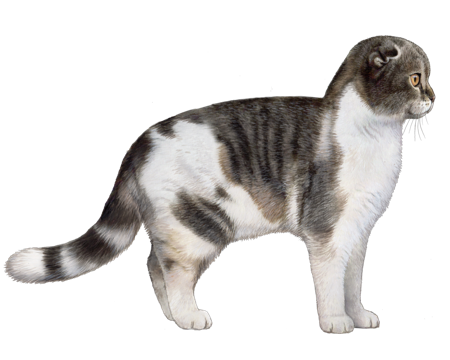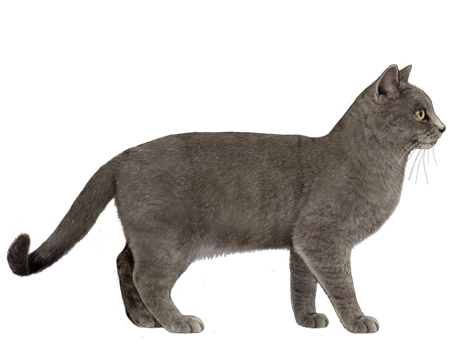
Scottish Straight
Scottish Straights are gentle, calm cats with characteristically round faces. Their sweet, friendly nature and low-key attitude make them an excellent fit for most families.
Interested in discovering if your cat is a Scottish Straight?
Check out Wisdom Panel's DNA test.
Scottish Straight Traits
General Appearance
Scottish Straights are medium-sized cats with an overall round appearance. They retain a sweet, kitten-like disposition throughout their lives.
Coat and Coloring
Scottish Straights come in both shorthair and longhair varieties. Shorthairs have dense, plush hair that stands away from the body, whereas longhairs have full coats with notable britches, tail plumes, toe tufts, and ear furnishings. Their coats come in nearly all colors and patterns.
Distinctive Physical Traits
Scottish Straights have rounded heads, adorable, wide-open eyes, and broad, short noses. Their ears are small-to-medium with rounded tips. And they have rounded, well-padded bodies and medium-to-long tails that are flexible and tapering.
Scottish Straight Temperament
Scottish Straights are relaxed cats with sweet personalities. They adapt well to different home environments—making them suitable for just about any type of family.
These loyal cats enjoy snuggling with their people and are world-class nappers. But when something gets their attention, they'll sit up like a prairie dog to see what's going on. Though not rowdy or overly energetic, they do like to play and can learn to fetch.
Scottish Straights are generally quiet cats. But when they have something to say, they use their tiny voice to get your attention.
Scottish Straight History
The Scottish Straight belongs to the Scottish breed group, along with the Scottish Fold. Both breeds come in longhair and shorthair varieties, and Scottish Straights are identical to Scottish Folds—save for their straight, upright ears.
Scottish Straights can trace their ancestry back to a white barn cat named Susie. Shepherd William Ross saw Susie at a farm in Scotland in 1961. Taken by the way her ears folded down on her head (the result of a rare mutation), Ross asked the farmer if he could have one of Susie's kittens.
Ross then bred the folded-ear kitten with a red tabby and subsequently crossed a kitten from that litter with a white British Shorthair. This resulted in five cats with folded ears—which became the foundation of the Scottish Fold breed. The rest were born with normal ears and became their own breed, the Scottish Straight.
Each breeding pair for the Scottish Fold must include a cat with non-folded ears. To promote genetic diversity, these matings usually include American or British shorthairs. But more recently, Scottish Straights have been accepted for breeding to Folds. Litters of such crossings are typically split with half of the kittens having folded ears and half having straight ears. Though Straights are not eligible for the show ring, they make lovely pets and endearing household companions.
Scottish Straight Care
Nutrition
These felines require a high-quality diet. Because nutritional needs vary for kittens, adults, and senior cats, opt for a formula that's age-appropriate for your pet.
Roughly one out of every three cats in the United States is overweight or obese. And those extra pounds can contribute to other health risks—such as arthritis, diabetes, and heart problems. To keep calories in check, measure out meals and reduce portions if necessary. And don't forget to account for treats. As a guideline, they should make up no more than 10% of a cat's calories.
Finally, all cats need access to fresh, clean water around the clock.
Grooming
Shorthair Straights have low-maintenance coats. Weekly brushing with a steel comb is enough to remove any loose fur and keep them looking their best. Longhair Straights need a bit more grooming—they require brushing a few times a week to prevent mats and tangles.
Most cats' nails require monthly trimming to prevent them from getting too long. Long nails are more likely to snag on something and become torn or damaged. They can even grow into your cat's paw pads, leading to pain or infection. In addition to clipping, providing a scratching post will allow your cat to do some nail maintenance themselves (thanks to their instinct to scratch).
No grooming routine is complete without a little dental hygiene. To support your cat's overall health, brush their teeth daily and schedule visits with your veterinarian for professional dental cleanings and exams.
Health
Some breeds are more susceptible to certain health conditions. Scottish Straights may be more likely to develop osteochondrodysplasia—an abnormality that affects cartilage and bone development. Your veterinarian is the best resource for these and other health concerns about your cat.
Scottish Straight Genetic Health Conditions
-
Polycystic Kidney Disease (PKD)
Polycystic Kidney Disease (PKD) is the most common inherited disease in cats. The disease causes the formation of fluid-filled cysts in the kidneys that can lead to kidney failure.
With more than 45 health tests, Wisdom Panel™ Complete for Cats screens for these and other important genetic conditions—allowing you to better plan for your cat's lifelong care.
Breed Group
Persian
An ever-popular variety, the breeds within this group tend to share a common genetic connection with Persian cats.
Resources
https://tica.org/breeds/browse-all-breeds?view=article&id=873:scottish-straight-breed&catid=79
https://cfa.org/scottish-fold/scottish-fold-article/
https://tica.org/phocadownload/sf.pdf
https://vcahospitals.com/know-your-pet/cat-breeds
https://www.banfield.com/state-of-pet-health/obesity
https://www.pethealthnetwork.com/cat-health/cat-breeds/scottish-fold-0
Reviewed February 23, 2021 by Annette Louviere, DVM

















